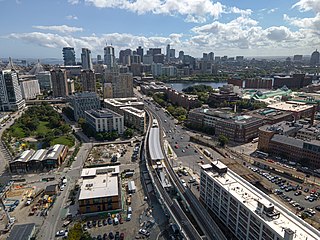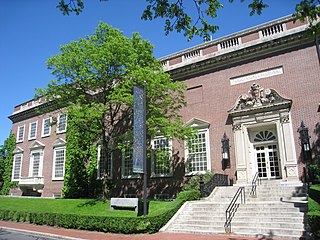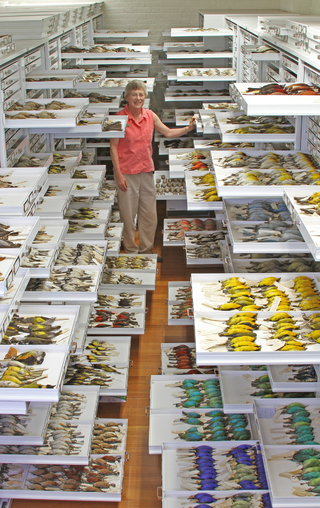
Harvard station is a rapid transit and bus transfer station in Cambridge, Massachusetts. Located at Harvard Square, it serves the MBTA's Red Line subway system as well as MBTA buses. Harvard averaged 18,528 entries each weekday in FY2019, making it the third-busiest MBTA station after Downtown Crossing and South Station. Five of the fifteen key MBTA bus routes stop at the station.

Lechmere Square is located at the intersection of Cambridge Street and First Street in East Cambridge, Massachusetts. It was originally named for the Colonial-era landowner Richard Lechmere, a Loyalist who returned to England at the beginning of the American Revolution. His lands were later seized by the new American government. The shoreline is shown as "Lechmere's Point" on Revolutionary War maps, and was the landing point for British troops en route to the Battles of Lexington and Concord.

Harvard University Press (HUP) is a publishing house established on January 13, 1913, as a division of Harvard University, and focused on academic publishing. It is a member of the Association of University Presses. After the retirement of William P. Sisler in 2017, the university appointed George Andreou as director.

Eblaite, or Palaeosyrian, is an extinct East Semitic language used during the 3rd millennium BC in Northern Syria. It was named after the ancient city of Ebla, in modern western Syria. Variants of the language were also spoken in Mari and Nagar. According to Cyrus H. Gordon, although scribes might have spoken it sometimes, Eblaite was probably not spoken much, being rather a written lingua franca with East and West Semitic features.

Berney Arms railway station is a stop on the Wherry Lines in the East of England, serving the settlement of Berney Arms on the Halvergate Marshes in Norfolk. It is located 15 miles 71 chains (25.6 km) east of Norwich and is the only station on a short stretch of single line between Reedham and Great Yarmouth. The station is managed by Greater Anglia, which also operates all trains serving it.
The Museum of Broadcast Communications (MBC) is an American museum, the stated mission of which is "to collect, preserve, and present historic and contemporary radio and television content as well as educate, inform and entertain through our archives, public programs, screenings, exhibits, publications and online access to our resources." It is headquartered in Chicago.

Café Pamplona was located at 12 Bow St. beside the intersection of Bow and Arrow Streets near Harvard Square in Cambridge, Massachusetts, United States. When it opened in 1959 it was the first café in the Square. The owner, Josefina Yanguas, claimed the café had the first espresso-maker in the city. Down a short flight of exterior stairs, past a patio with tables, customers entered the café's subterranean interior. The once austere decor included bright yellow lights which made the thickly-plastered walls glow under low ceilings, and a black and white checked floor. The café survived the changes that had taken place since the mid-1980s.

The Harvard Art Museums are part of Harvard University and comprise three museums: the Fogg Museum, the Busch-Reisinger Museum, and the Arthur M. Sackler Museum, and four research centers: the Archaeological Exploration of Sardis, the Center for the Technical Study of Modern Art, the Harvard Art Museums Archives, and the Straus Center for Conservation and Technical Studies. The three museums that constitute the Harvard Art Museums were initially integrated into a single institution under the name Harvard University Art Museums in 1983. The word "University" was dropped from the institutional name in 2008.
Parsons Field is a 7,000-seat multi-purpose stadium in Brookline, Massachusetts. It is home to the Northeastern University baseball, men's and women's soccer, men's and women's lacrosse, men's and women's rugby as well as the Brookline High School Warriors football team. Additionally, the stadium was the home of the Northeastern Huskies football team until it was disbanded following the 2009 season. The capacity for baseball is 3,000. The facility opened in 1933.

The Museum of Comparative Zoology is a zoology museum located on the grounds of Harvard University in Cambridge, Massachusetts. It is one of three natural-history research museums at Harvard, whose public face is the Harvard Museum of Natural History. Harvard MCZ's collections consist of some 21 million specimens, of which several thousand are on rotating display at the public museum. In July 2021, Gonzalo Giribet, Alexander Agassiz Professor of Zoology at Harvard and Curator of Invertebrate Zoology, was announced as the new director of the museum.
Warwick Mall is an enclosed American shopping mall in Warwick, Rhode Island, on the north side of Interstate 295 near the junction with Interstate 95. Composed of more than 1,000,000 square feet (93,000 m2) of retail space, it features more than 80 stores and a food court. The mall opened for business in 1970, with Boston-based Filene's and Jordan Marsh alongside Providence-based Peerless and The Outlet, and national chain Woolworth as initial anchors, JCPenney being later added as a sixth anchor.

The Museum of Archaeology and Anthropology, also known as MAA, at the University of Cambridge houses the university's collections of local antiquities, together with archaeological and ethnographic artefacts from around the world. The museum is located on the university's Downing Site, on the corner of Downing Street and Tennis Court Road. In 2013 it reopened following a major refurbishment of the exhibition galleries, with a new public entrance directly on to Downing Street.
Cambridge Health Alliance (CHA) is a healthcare provider in Cambridge, Somerville and Boston's metro-north communities in Massachusetts. CHA offers services including primary care, specialty care, and mental health/substance use services. It includes two acute care hospitals, primary care and specialty practice facilities, and the Cambridge Public Health Department. CHA maintains an affiliation with Beth Israel Deaconess Medical Center in Boston and is a Tufts University School of Medicine and Harvard Medical School teaching affiliate.

Children's Wharf is a wharf on Congress Street in Boston, Massachusetts, on the Fort Point Channel with views of the Financial District and Boston Harbor. The wharf has sitting areas, patches of lawn, and several tourist attractions.

Cambridge Highlands also known as "Area 12", is a neighborhood of Cambridge, Massachusetts bounded by the railroad tracks on the north and east, the Belmont town line on the west, and Fresh Pond on the south. In 2005 it had a population of 673 residents living in 281 households, and the average household income was $56,500.

The Boston Medical Library of Boston, Massachusetts, was originally organized to alleviate the problem that had emerged due to the scattered distribution of medical texts throughout the city. It has evolved into the "largest academic medical library in the world".

Queen Street Mill is a former weaving mill in Harle Syke, a suburb to the north-east of Burnley, Lancashire, that is a Grade I listed building. It now operates as a museum and cafe. Currently open for public tours between April and November. Over winter the café is opened on Wednesdays. It is also viewable with private bookings.

Boylston Hall is a Harvard University classroom and academic office building lecture hall near the southwest corner of Harvard Yard, Cambridge, Massachusetts.
Grossman Library, located at its closure on the third floor of Sever Hall in Harvard Yard, was the Harvard Extension School's primary library. It is part of the Harvard College Library, the library system of Harvard's Faculty of Arts and Sciences. It was a reserve reading and study library, named in 1982 for alumnus and benefactor Edgar Grossman.
During the Vietnam War, Harvard University was the site of a number of protests against both the war generally and Harvard's connections to the war specifically.
















